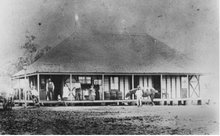According to Frank Snars, in addition to sugar cane, a wide variety of other crops were grown in the area including oats, lucerne, maize, cotton, arrowroot, potatoes, panicum, sorghum, imphee, pumpkins, rape (canola), mangel-wurzels and a wide variety of fruits and domestic vegetables.
Admitting to wide agricultural ignorance, I had to look up some of the crops. According to Queensland’s Department of Primary Industry “Millets and panicums are small-seeded, quick-maturing summer crops ideal for double cropping and changeover cropping.” Imphee is African sugar cane (Holcus saccharatus), which resembles sorghum, or Chinese sugar cane.
I have always wanted to know what a
Back to the subject of wildlife, Fred Kleidon wrote that “Fences 4 feet high made of palings split from the trunks of tree were erected around the crops of maize, potatoes, cotton and vegetables to stop the wallabies, bandicoots and cattle from eating them.”
Wallabies and bandicoots are much rarer today. Perhaps because I am not a morning person, nor required to be setting off for work in the early dawn, I rarely see much wildlife. We will occasionally see a wallaby hopping across the paddocks behind our house or bouncing through the fences. I have even seen echidnas wandering across the road. The last week however, we have had a visitor hanging around our house. On Sunday morning, a wallaby was sleeping in the shade of the trampoline. This morning as I sleepily washed my face, I practically came face to face with it outside the bathroom window. It is shy but not frightened. It will look at us though the window until some creak of the floorboards or noise sets it off. I am amazed by its beauty, but concerned by its predilection for proximity to houses. I wonder if it is eating the grass or if it is a gourmet, snacking lightly on rocket, basil, mint and parsley. We are lucky that we can enjoy its presence without worrying about its intrusion.

No comments:
Post a Comment